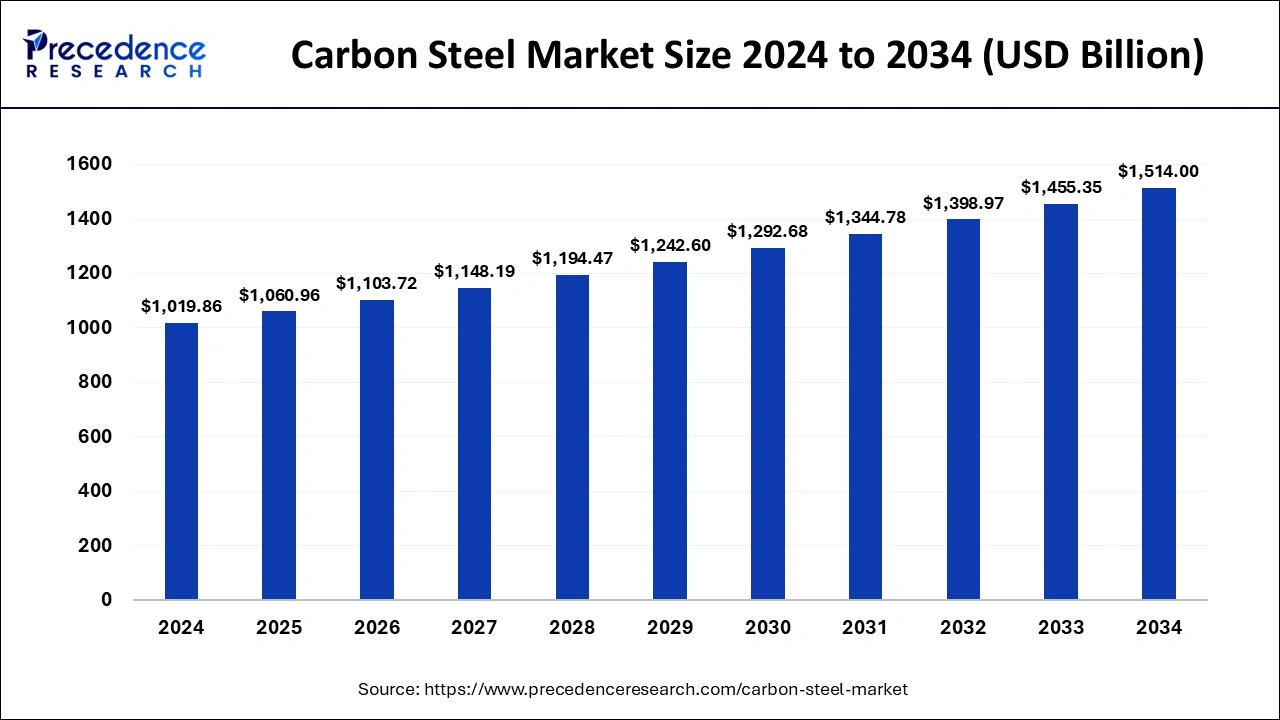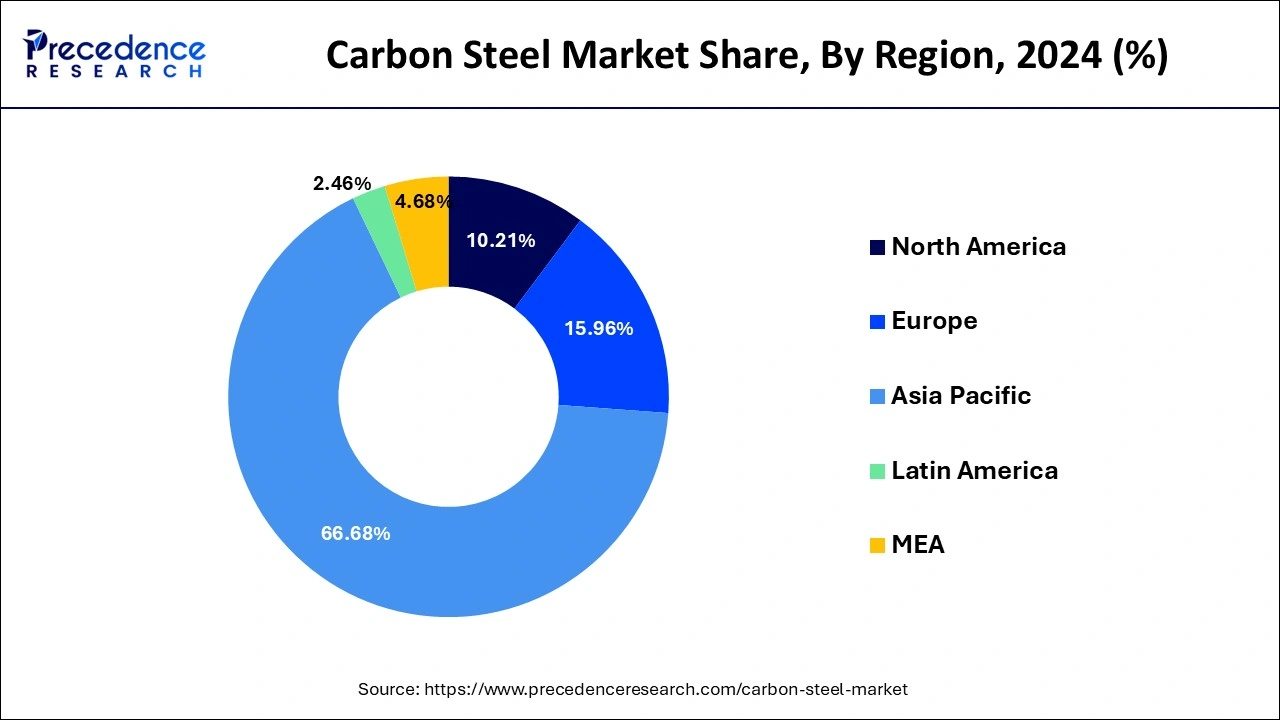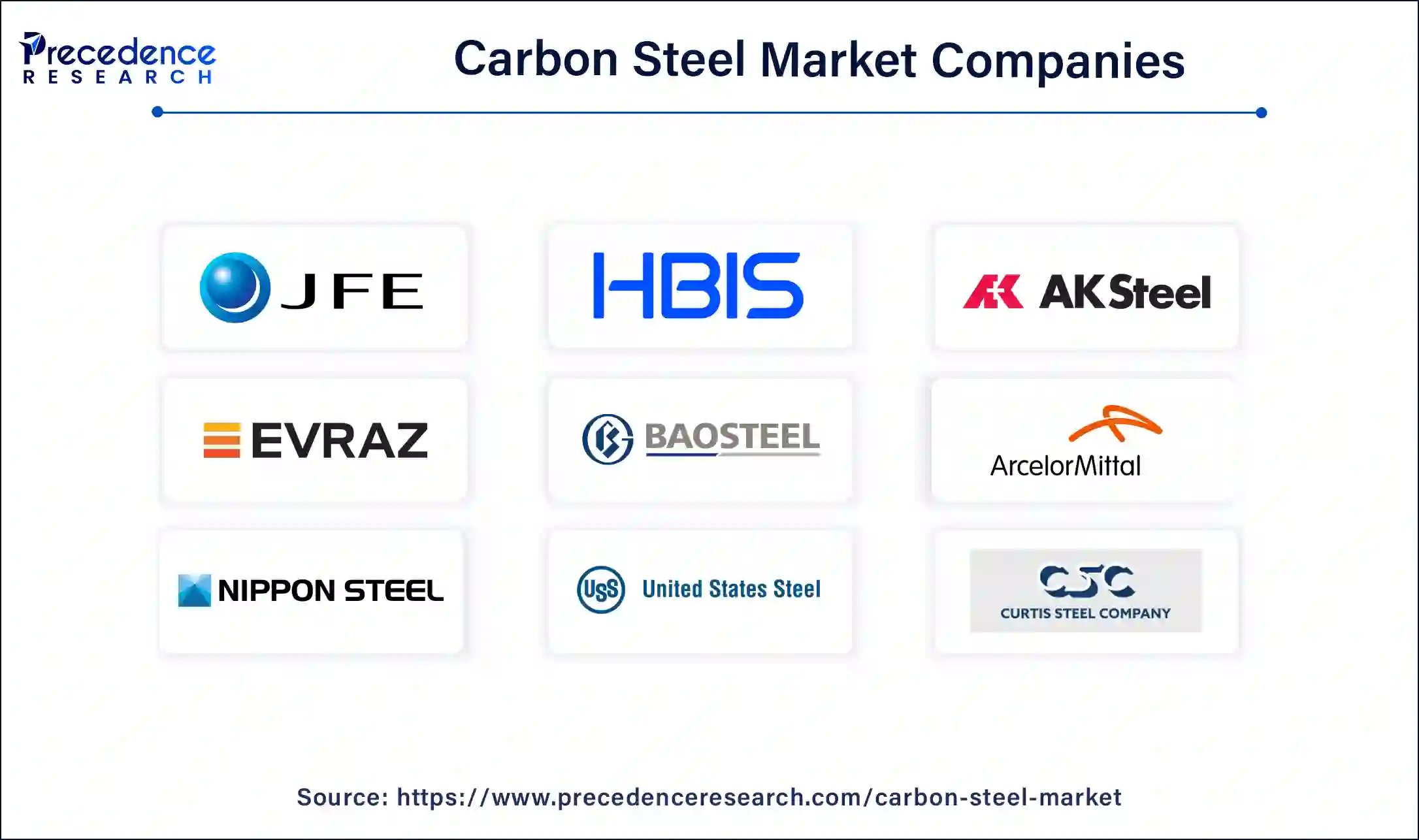List of Contents
Carbon Steel Market Size and Forecast 2025 to 2034
The global carbon steel market size was worth around USD 1,019.86 billion in 2024 and is predicted to surpass around USD 1,514 billion by 2034, growing at a CAGR of 4.03% from 2025 to 2034. The carbon steel market is driven by the rising demand from the construction industry, mainly bolstered by urbanization.

Carbon Steel Market Key Takeaways
- Asia Pacific dominated the global market with the largest market share of 66.68% in 2024.
- North America is projected to expand at the fastest CAGR during the forecast period.
- By type, the low carbon steel segment contributed the highest market share in 2024.
- By type, the medium carbon steel segment is expected to grow at a significant CAGR from 2025 to 2034.
- By application , the shipbuilding segment captured the biggest market share in 2024.
- By application, the construction segments is estimated to be the fastest-growing segment during the forecast period.
How is AI enhancing the carbon steel industry?
Carbon steel industry has embraced artificial intelligence to transform its processes by optimizing different aspects of steel production, from improving process efficiency to ensuring the best quality products. It even helps optimize energy usage by adjusting the heating and cooling processes, reducing waste, and ensuring energy-intensive equipment operates efficiently.
AI contributes to identifying faults in steel products through advanced computer vision techniques. High-resolution cameras and sensors are used to seize detailed images of steel surfaces. Its algorithms then analyze these images to spot imperfections like surface irregularities, cracks, or impurities. This automated process is far more concise and efficient than manual inspections, ensuring that even the tiniest defects are not overlooked.
Asia Pacific Carbon Steel Market Size and Growth 2025 to 2034
The Asia Pacific carbon steel market size was exhibited at USD 680.04 billion in 2024 and is projected to be worth around USD 1,010.60 billion by 2034, growing at a CAGR of 4.04% from 2025 to 2034.

Asia Pacific is dominating the carbon steel market. Within the region, China is entitled to the largest market share. The rising demand for carbon steel in industries and factories leads to the growth of this market. The automation and AI technology optimize the production line. Machine learning includes a sensor device that detects defects in the process. These technologies encourage the carbon steel market to expand globally. The innovative space is being acquired by new developmental projects in several other sectors.
- Hyundai Steel is stretching its low-carbon plate sales base in international markets like Europe and the Americas in response to the global need for carbon neutrality and the European Cross-Border Carbon Adjustment Mechanism. The Korea Herald reports this. The company signed memorandums acknowledgment with Czech auto parts producer Tawesco and Italian automotive sheet processing firm Eusider to supply reduced carbon steel plates. These firms supply materials to major European automakers such as Volkswagen.

The North America is estimated to be the most opportunistic segment during the forecast period. The carbon steel demand in the U.S. has benefited from strong economic development fueled by government-led fiscal stimulus, resulting in high company confidence. This resulted in a significant increase in construction spending in the North America region.
- In April 2024, United States Steel Corporation and CarbonFree declared the signing of a definitive agreement to seize carbon emissions generated from U. S. Steel's Gary Works Blast Furnaces in a first-of-its-kind project. The project will use CarbonFree's SkyCycle technology to seize and mineralize up to 50,000 metric tons of CO2 per year, equivalent to emissions of nearly 12,000 passenger cars annually.
Technological Advancement
Technological advancements in the carbon steel market feature automation, AI, smart steel, advanced coatings, 3D printing, and heat treatment and alloying methods. Heat treatment and alloying methods are modern technologies that help in achieving quality production performance for applications. 3D printing with steel enables customization, making new designs in applications. Smart steel technology combines AI and materials science to encourage development. The advanced coating is an innovation-based technology used for finishing products, mainly considered by the construction and automotive sectors.
Carbon Steel Market Growth Factors
Carbon steel is an alloy made up of steel and carbon concentration of at least 2.1%. The carbon steel is classified into three types such as low carbon steel, medium carbon steel and high carbon steel. Carbon steels are typically soft and have a low compressive strength. They do, however, have a high ductility, making them ideal for machining and welding, as well as being inexpensive in nature.
The automobile body components, structural shapes such as angle iron and I-beams, pipes, building and bridge components, and food cans all use low carbon steels. The medium-carbon steels are commonly used for railway tracks, train wheels, and equipment parts that require the high strength, wear resistance, and toughness. The high-carbon steels are utilized in cutting tools, springs, great-strength wire because of their high wear resistance and hardness.
The spheroidizing, complete annealing, isothermal annealing, quenching, martempering, and a variety of other techniques can all be used to improve the characteristics of carbon steel. By tempering carbon steel with the inherent qualities of a specific type of carbon steel, it can be employed in a variety of end-user industries. The weldability factor is lower in carbon steel with a high carbon content.
One of the most extensively utilized end-user industry alloys in carbon steel. The inclusion of carbon in steel, on the other hand, boosts its strength and hardness, making it a desirable material for producers in the automotive and construction industries.
The rising gross domestic product (GDP) of developing countries in Asia-Pacific, Latin America, and the Middle East is resulting in rapid urbanization, which is boosting construction activity. This is helping to drive up demand for carbon steel, which is used to make small utensils and wires. The rise in urbanization and industrialization has resulted in the growth of carbon steel market during the forecast period.
The carbon steel is used in a variety of products, including automobile parts. Aside from the wide range of uses, technological advancements that have resulted in the development of higher quality carbon steel are also boosting demand.
The carbon steel's ductility and forming qualities make it suitable for automobile body structures and trunk closures, as well as wear resistant gears. The medium carbon steel is also employed in the automotive industry since it has higher strength and endurance than low carbon steel but less ductility. The carbon steel use in the automotive industry is predicted to increase as the emphasis on lightweight vehicles grows.
However, one disadvantage of carbon steel is preventing wider adoption. The welding of carbon steel is the challenging part. Carbon content reduces the steel's temperature resistance and melting point, lowering the steel's weldability.
Market Scope
| Report Highlights | Details |
| Market Size by 2034 | USD 1,514 Billion |
| Market Size in 2025 | USD 1,060.96 Billion |
| Market Size in 2024 | USD 1,019.86 Billion |
| Market Growth Rate from 2025 to 2034 | CAGR of 4.03% |
| Largest Market | Asia Pacific |
| Base Year | 2024 |
| Forecast Period | 2025 to 2034 |
| Segments Covered | Type, Application, and Regions |
| Regions Covered | North America, Europe, Asia-Pacific, Latin America and Middle East & Africa |
Type Insights
The low carbon steel dominates the carbon steel market during the forecast period. The carbon content is less than 0.25% by weight in low carbon steel. The low carbon steel can be formed into a variety of shapes, from structural beams to flat sheets. It has ductility, malleability, and the ability to form cold. When compared to its substitutes, it is cheap in nature.
The medium carbon steel is expected to grow at rapid pace during the forecast period. The carbon and manganese content of medium carbon steel is more than that of low carbon steel, making it stronger but more difficult to shape. It is popular in the production of machine and automotive parts due to its properties such as high strength and good weldability.
Application Insights
The shipbuilding segment dominated the market with highest market share during 2024. Steel is used in shipbuilding because of its mechanical characteristics and affordable price. The carbon steel is critical in the shipbuilding industry, but declining industry growth and a preference for replacements such aluminum alloys are expected to limit product use in the shipbuilding sector throughout the forecast period.
The construction segment is fastest growing segment in the carbon steel market. The low carbon steel has great forming and welding capabilities, as well as benefits such as no bending fractures, flexibility, ductility, plasticity, and earthquake resistance, making it a popular choice in the construction industry. The strength of carbon steel in severe scenarios is its primary advantage, since it protects the building from falling and saves the residents.
Carbon Steel Market Companies

- JFE Steel Corporation
- HBIS Group
- AK Steel Corporation
- Evraz PLC
- Baosteel Group
- ArcelorMittal
- Nippon Steel Corporation
- United States Steel
- Curtis Steel Co. Ltd
- Omega Steel Company
Latest Announcements by Industry Leaders
- In May 2023, Cleveland-Cliffs Inc. disclosed fulfilling a hydrogen injection trial at its Middletown Works blast furnace. This innovative establishment of hydrogen gas as aniron-reducing agent in the blast furnace is the first-ever usage of this carbon-friendly technology in the Americas region.
Recent Developments
- In February 2025, the global steel industry marked a milestone with the launch of “Mastering Carbon Steel Sourcing: From domestic suppliers to global partnership,” the world's first book on carbon steel sourcing.
- In January 2025, Volvo CE implemented low-carbon emission steel into the serial production of all its articulated haulers built in Braas, Sweden. This will help customers reduce emissions.
- In May 2025, EMSTEEL launched a green finance framework to fund low-carbon steel, cement, and renewable energy projects. This framework will eventually boost multiple markets, including the carbon steel market.
- In August 2024, global steelmaker ArcelorMittal launched a low-carbon transport service to deliver steel to European customers, which will help reduce CO2 emissions from road transport by about 90%. The service is highly contributing to the improvement of the logistics sector and indirectly promoting carbon steel production industries.
- In August 2024, Nippon Steel Corporation declared additional project investments to be made at Mon Valley Works and Gary Works as part of its pending United States Steel Corporation acquisition. The investments disclosed are major growth investments and represent additional capital spending that will stretch the production life of two of U. S. Steel's critical integrated assets and improve the security of steel supply to American manufacturers.
Segments Covered in the Report
By Type
- Low Carbon Steel
- Medium Carbon Steel
- High Carbon Steel
By Application
- Shipbuilding
- Automotive
- Construction
- Others
By Geography
- North America
- Asia Pacific
- Europe
- Latin America
- Middle East and Africa
For inquiries regarding discounts, bulk purchases, or customization requests, please contact us at sales@precedenceresearch.com
Frequently Asked Questions
Ask For Sample
No cookie-cutter, only authentic analysis – take the 1st step to become a Precedence Research client